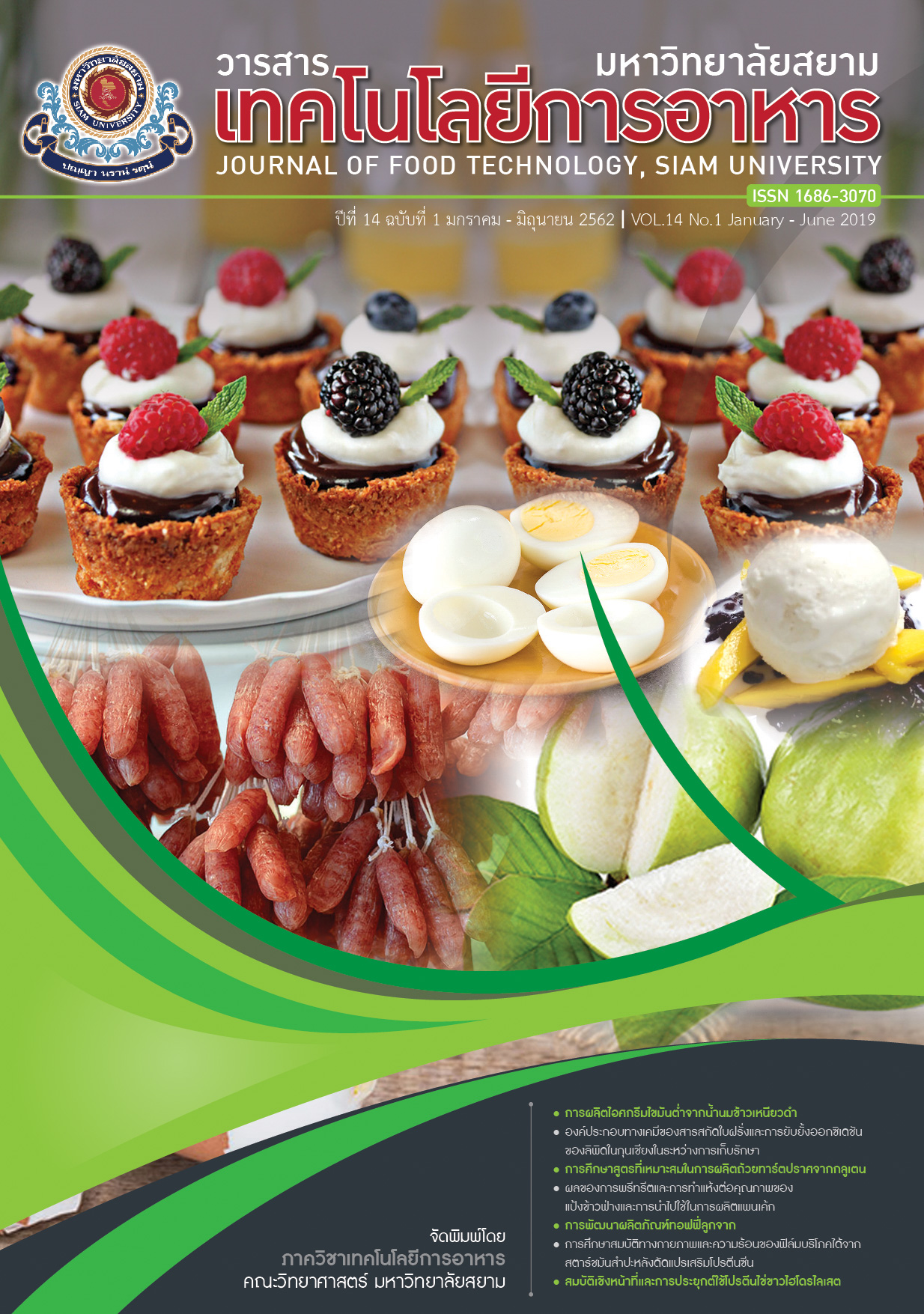A Study of Suitable Formula for Gluten-free Tart Cups Production
Main Article Content
Abstract
This research aimed to optimize the ingredients to produce gluten-free tart cups. The thirteen formulations of tart cups consisting of mixed flour (non-glutinous rice flour, potato flour and cassava flour), salted butter and icing sugar were studied by using Mixture Design. Physical properties and sensory evaluation by untrained panelists were investigated. Obviously, the mixture response surface contour plots showed that the percentage baking loss of the tart cup varied proportionately with the mixed flour and salted butter content. The specific volume increased with increasing butter content. Moreover, hardness increased with increasing mixed flour content. Interestingly, a suitable formulation of gluten-free tart cup was 50% mixed flour, 30% salted butter and 20% icing sugar, respectively. This formulation had the highest score of appearance, flavor, taste, texture and overall liking. Furthermore, adding riceberry germ, black sesame seed and dried seaweed in tart cups were studied. The results showed that the formula with black sesame seed had the highest average overall liking score (8.13+0.78) with the level of like moderately. In conclusion, gluten-free tart cups are an alternative for consumers who want to avoid gluten containing foods.
Article Details
Copyrights of all articles in the Journal of Food Technology available in print or online are owned by Siam University and protected by law.
References
standards.html. [Accessed May, 31, 2018]
[2] Rattanapanone, N. Food chemistry. Bangkok: Odeon Store, 2006, 504.
[3] Fitterman, L. Inside the race for a celiac disease treatment. 2018. [Online] Available from: https://www.allergicliving.com. [Accessed May, 30, 2018]
[4] Surojanametakul, V. Coeliac disease and the importance of gluten-free foods. Food Journal (Thailand), 2013, 43, 16-21.
[5] Charoenphun, N. Development of cookie products from sweet potato. Journal of Food Technology, Siam University, 2018, 13, 32-43.
[6] Somboonpanyakul, P., Hudthagosol, C., Meekhruerod, A., Lasukhang, W. and Chuaduangpuy, D. Development of sinlek brown rice cookie. Agricultural Science Journal, 2012, 43, 565-568.
[7] Charoenphun, N. and Kwanhian, W. Effect of flour from durian waste on quality of gluten free pasta. Thammasat Journal of Science and Technology, 2018, 26, 803-814.
[8] Inchuen, S., Naratippakorn, T. and Kheawruang, S. Effect of holy basil leaf powder on wheat flour property and cookies quality. Khon Kaen Agriculture Journal, 2018, 46, 1387-1394.
[9] Sharma, P. and H. Gujral. Cookie making behavior of wheat-barley flour blends and effects on antioxidant properties. LWT – Food Science and Technology, 2014, 55, 301-307.
[10] Duncan, D. B. Multiple range and multiple F tests. Biometrics, 1995, 11, 1–42.
[11] Kotoki, D. and Deka, S. C. Baking loss of bread with special emphasis on increasing water holding capacity. Journal of Food Science and Technology, 2010, 47, 128-131.
[12] Luangsakul, N., Katekasem, P., Suksawang, M. and Pornanansiri, S. The effects of the amount and type of wheat flour and mixing method on the quality of fortune cookies.
2012. [Online] Available from: https://www.lib.ku.ac.th/KUCONF/2555/KC4906034.pdf [Accessed May, 30, 2018]
[13] Naiwikun, O. Rice: Science and Technology. Bangkok: Kasetsart, 2007, 366.
[14] Ratthanatham, P., Laohakunjit, N. and Kerdchoechuen, O. Phenolic compound, anthocyanin and antioxidant activity of germinated colored rice. Agricultural Science Journal, 2013, 44, 441-444.
[15] Srisayam, M., Weerapreeyakul, N. and Sribuarin, P. In vitro antioxidant activity of white, black and red sesame seeds. Isan Journal of Pharmaceutical Sciences, 2014, 10, 136-146.
[16] Yangthong, M. and Thawonsuwan, J. Nutritional evaluation and antibacterial activity of seaweeds. Journal of Fisheries Technology Research, 2016, 10, 68-77.

